Arrangement
In
Classical music
Arrangement and transcriptions of classical and serious music go back to the early history of this genre.
Eighteenth century

Bach transformed this solo piece into an orchestral Sinfonia that introduces his Cantata BWV29. "The initial violin composition was in E major but both arranged versions are transposed down to D, the better to accommodate the wind instruments".[4]
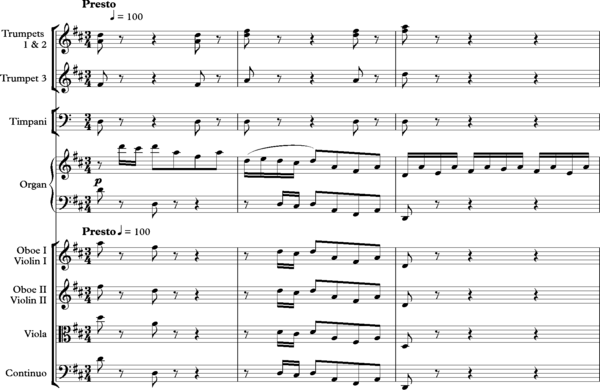
"The transformation of material conceived for a single string instrument into a fully orchestrated concerto-type movement is so successful that it is unlikely that anyone hearing the latter for the first time would suspect the existence of the former".[5]
Nineteenth and twentieth centuries
Piano music
In particular, music written for the
Erik Satie wrote his three Gymnopédies for solo piano in 1888.

Eight years later,
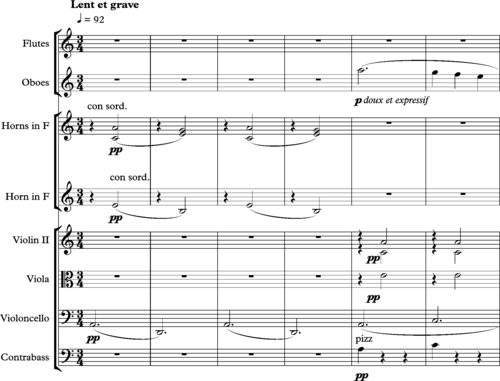

Pictures at an Exhibition, a suite of ten piano pieces by Modest Mussorgsky, has been arranged over twenty times, notably by Maurice Ravel.[9] Ravel's arrangement demonstrates an "ability to create unexpected, memorable orchestral sonorities".[10] In the second movement, "Gnomus", Mussorgsky's original piano piece simply repeats the following passage:

Ravel initially orchestrates it as follows:

Repeating the passage, Ravel provides a fresh orchestration "this time with the celesta (replacing the woodwinds) accompanied by string glissandos on the fingerboard".[10]

Songs
A number of Franz Schubert's songs, originally for voice with piano accompaniment, were arranged by other composers. For example, his "highly charged, graphic" song "Erlkönig" ("The Erl King") has a piano introduction that conveys "unflagging energy" from the start:[11]

The arrangement of this song by Hector Berlioz uses strings to convey faithfully the driving urgency and threatening atmosphere of the original.
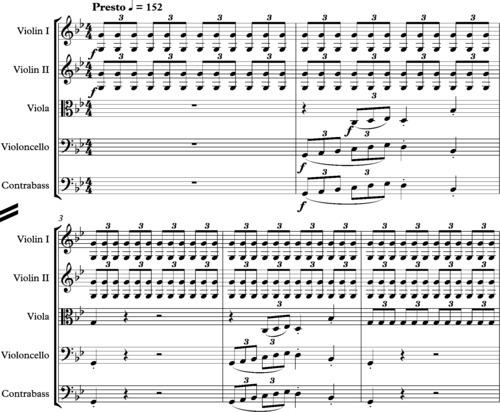
Berlioz adds colour in bars 6–8 through the addition of woodwind, horns, and a timpani. With typical flamboyance, Berlioz adds spice to the harmony in bar 6 with an E flat in the horn part, creating a half-diminished seventh chord which is not in Schubert's original piano part.
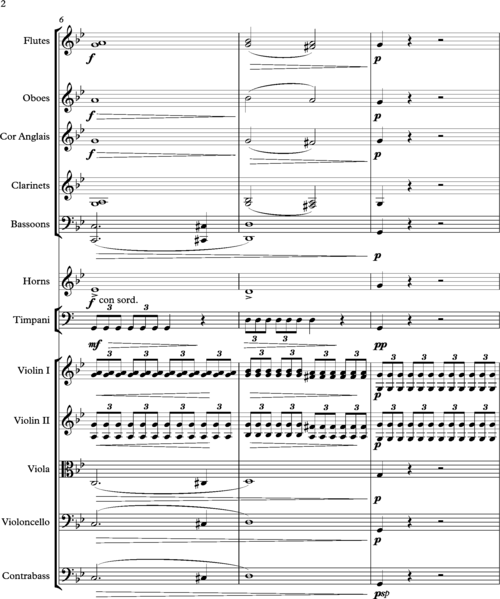
There are subtle differences between this and the arrangement of the song by
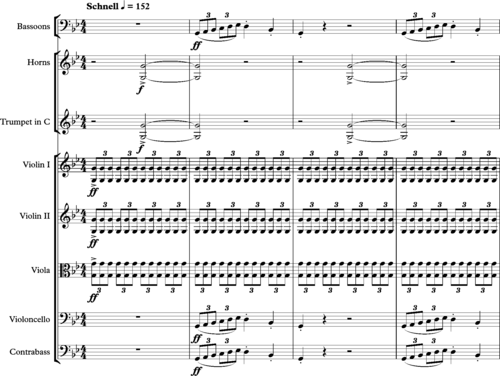
Unlike Berlioz, Liszt does not alter the harmony, but changes the emphasis somewhat in bar 6, with the note A in the oboes and clarinets grating against rather than blending with the G in the strings.

"Schubert has come in for his fair share of transcriptions and arrangements. Most, like Liszt's transcriptions of the Lieder or Berlioz's orchestration for Erlkönig, tell us more about the arranger that about the original composer, but they can be diverting so long as they are in no way a replacement for the original".[12]
Gustav Mahler's Lieder eines fahrenden Gesellen ("Songs of a Wayfarer") were originally written for voice with piano accompaniment. The composer's later arrangement of the piano part shows a typical ear for clarity and transparency in re-writing for an ensemble. Here is the original piano version of the closing bars of the second song, "Gieng heit' Morgen über's Feld":

The orchestration shows Mahler's attention to detail in bringing out differentiated orchestral

Popular music
Well-known examples include
Jazz
Arrangements for small jazz combos are usually informal, minimal, and uncredited. Larger ensembles have generally had greater requirements for notated arrangements, though the early Count Basie big band is known for its many head arrangements, so called because they were worked out by the players themselves, memorized ("in the player's head"), and never written down.[17] Most arrangements for big bands, however, were written down and credited to a specific arranger, as with arrangements by Sammy Nestico and Neal Hefti for Count Basie's later big bands.[18]
Don Redman made innovations in jazz arranging as a part of Fletcher Henderson's orchestra in the 1920s. Redman's arrangements introduced a more intricate melodic presentation and soli performances for various sections of the big band.[19] Benny Carter became Henderson's primary arranger in the early 1930s, becoming known for his arranging abilities in addition to his previous recognition as a performer.[19] Beginning in 1938, Billy Strayhorn became an arranger of great renown for the Duke Ellington orchestra. Jelly Roll Morton is sometimes considered the earliest jazz arranger. While he toured around the years 1912 to 1915, he wrote down parts to enable "pickup bands" to perform his compositions.
Big-band arrangements are informally called charts. In the swing era they were usually either arrangements of popular songs or they were entirely new compositions.[20] Duke Ellington's and Billy Strayhorn's arrangements for the Duke Ellington big band were usually new compositions, and some of Eddie Sauter's arrangements for the Benny Goodman band and Artie Shaw's arrangements for his own band were new compositions as well. It became more common to arrange sketchy jazz combo compositions for big band after the bop era.[21]
After 1950, the big bands declined in number. However, several bands continued and arrangers provided renowned arrangements. Gil Evans wrote a number of large-ensemble arrangements in the late 1950s and early 1960s intended for recording sessions only. Other arrangers of note include Vic Schoen, Pete Rugolo, Oliver Nelson, Johnny Richards, Billy May, Thad Jones, Maria Schneider, Bob Brookmeyer, Lou Marini, Nelson Riddle, Ralph Burns, Billy Byers, Gordon Jenkins, Ray Conniff, Henry Mancini, Ray Reach, Vince Mendoza, and Claus Ogerman.
In the 21st century, the big-band arrangement has made a modest comeback. Gordon Goodwin, Roy Hargrove, and Christian McBride have all rolled out new big bands with both original compositions and new arrangements of standard tunes.[22]
For instrumental groups
Strings
The
The
A group of instruments in which each member plays a unique part—rather than playing in unison with other like instruments—is referred to as a chamber ensemble.[26] A chamber ensemble made up entirely of strings of the violin family is referred to by its size. A string trio consists of three players, a string quartet four, a string quintet five, and so on.
In most circumstances the string section is treated by the arranger as one homogeneous unit and its members are required to play preconceived material rather than improvise.
A string section can be utilized on its own (this is referred to as a string orchestra)[27] or in conjunction with any of the other instrumental sections. More than one string orchestra can be utilized.
A standard string section (vln., vln 2., vla., vcl, cb.) with each section playing unison allows the arranger to create a five-part texture. Often an arranger will divide each violin section in half or thirds to achieve a denser texture. It is possible to carry this division to its logical extreme in which each member of the string section plays his or her own unique part.
Size of the string section
Artistic, budgetary and logistical concerns, including the size of the orchestra pit or hall will determine the size and instrumentation of a string section. The Broadway musical West Side Story, in 1957, was booked into the Winter Garden theater; composer Leonard Bernstein disliked the playing of "house" viola players he would have to use there, and so he chose to leave them out of the show's instrumentation; a benefit was the creation of more space in the pit for an expanded percussion section.[28]
While any combination and number of string instruments is possible in a section, a traditional string section sound is achieved with a violin-heavy balance of instruments.
| Reference | Author | Section size | Violins | Violas | Celli | Basses |
|---|---|---|---|---|---|---|
| "Arranged By Nelson Riddle"[30] | Nelson Riddle | 12 players | 8 | 2 | 2 | 0 |
| 15 players | 9 | 3 | 3 | 0 | ||
| 16 players | 10 | 3 | 3 | 0 | ||
| 20 players | 12 | 4 | 4 | 0 | ||
| 30 players | 18 | 6 | 6 | 0 | ||
| "The Contemporary Arranger"[31] | Don Sebesky | 9 players | 7 | 0 | 2 | 0 |
| 12 players | 8 | 2 | 2 | 0 | ||
| 16 players | 12 | 0 | 4 | 0 | ||
| 20 players | 12 | 4 | 4 | 0 |
Further reading
| Name | Author |
|---|---|
| Inside the score: A detailed analysis of 8 classic jazz ensemble charts by Sammy Nestico, Thad Jones and Bob Brookmeyer | Rayburn Wright |
| Sounds and Scores : A Practical Guide to Professional Orchestration | Henry Mancini |
| The Contemporary Arranger | Don Sebesky |
| The Study of Orchestration | Samuel Adler |
| Arranged by Nelson Riddle | Nelson Riddle |
| Instrumental Jazz Arranging: A Comprehensive and Practical Guide | Mike Tomaro |
| Modern Jazz Voicings: Arranging for Small and Medium Ensemble | Ted Pease, Ken Pullig |
| Arranging for Large Jazz Ensemble | Ted Pease, Dick Lowell |
| Arranging concepts complete: the ultimate arranging course for today's music | Dick Grove |
| The complete arranger | Sammy Nestico |
| Arranging Songs: How to Put the Parts Together | Rikky Rooksby |
See also
- Transcription (music)
- Instrumentation (music)
- Orchestration
- Reduction (music)
- Musical notation
- American Society of Music Arrangers and Composers
- Electronic keyboard (or Electronic Music Arranger), which allows for live music arrangement
- List of music arrangers
- List of jazz arrangers
- Category:Music arrangers
References
- ^ "Arrangement". Britannica. Retrieved 16 October 2020.
- ^ (Corozine 2002, p. 3)
- ISBN 978-0-141-02646-6.
- ^ Mincham, J. (2016) the Cantatas of Johan Sebastian Bach. http://www.jsbachcantatas.com/documents/chapter-85-bwv-29/ Retrieved 31 August 2020.
- ^ Mincham, J. (2016), The Cantatas of Johann Sebastian Bach. http://www.jsbachcantatas.com/documents/chapter-85-bwv-29/ Retrieved 31 August 2020.
- ^ Arrangement, Encyclopædia Britannica online
- ISBN 0-7148-3504-8.
- ^ Taruskin, R. (2010, p. 70) The Oxford History of Western Music, Music in the early Twentieth Century. Oxford University Press.
- ^ Partial list of orchestral arrangements to Pictures at an Exhibition
- ^ a b Orenstein, A. (2016, p. VIII. Preface to Mussorgsky-Ravel, Pictures at an Exhibition. Miniature score, London, Eulenburg.
- ^ Newbould, B. (1997, p. 57) Schubert: the Music and the Man. London, Gollancz.
- ^ Newbould, B. (1997, p. 467) Schubert: the Music and the Man. London, Gollancz.
- ^ Vanilla Fudge covers (classic bands website)
- ^ Close To the Edge – The Story of Yes, Chris Welch, Omnibus Press, 1999/2003/2008 pages 33-34
- ^ Bonnie Pointer bio (IMDb website)
- ISBN 978-0-240-81458-2) page 47
- ^ Randel 2002, p. 294
- ^ Swing music history and the big bands (Jazz in America website)
- ^ a b "JAZZ A Film By Ken Burns: Selected Artist Biography - Fletcher Henderson". PBS. 25 September 1934. Retrieved 18 October 2013.
- ISBN 978-0-393-06861-0
- ^ Bailey, C. Michael (11 April 2008). "Miles Davis, Miles Smiles, and the Invention of Post Bop". All About Jazz. Retrieved 23 February 2013.
- ^ "Carrington and Correa Among Jazz Winners" – LATimes Blog, Feb. 2012
- ISBN 9780393975727.
- ISBN 9780393975727.
- ^ Sebesky, Don (1975). The Contemporary Arranger. New York: Alfred Pub. p. 117.
- ^ "Oxford Music Online". Retrieved 22 July 2011.
- ^ "String orchestra". Collins English Dictionary (11th ed.). Retrieved 21 October 2012.
- ^ Burton, Humphrey. "Leonard Bernstein by Humphrey Burton, Chapter 26". Archived from the original on 29 June 2011. Retrieved 22 July 2011.
- ^ Martin, George (1983). Making Music: the Guide to Writing, Performing & Recording. New York: W. Morrow. p. 82.
- ^ Riddle, Nelson (1985). Arranged By Nelson Riddle. Secaucus, NJ: Warner Brothers Publications Inc. p. 124.
- ^ Sebesky, Don (1975). The Contemporary Arranger. New York: Alfred Pub. pp. 127–129.
- Sources
- Corozine, Vince (2002). Arranging Music for the Real World: Classical and Commercial Aspects. Pacific, MO: Mel Bay. OCLC 50470629.
- Kers, Robert de (1944). Harmonie et orchestration pour orchestra de danse. Bruxelles: Éditions musicales C. Bens. vii, 126 p.
- Kidd, Jim (1987). Unsung Heroes, the Jazz Arrangers, from Don Redman to Sy Oliver: [text with recorded examples for a presentation] Prepared on the Occasion of the 16th Annual Canadian Collectors' Congress, 25 April 1987, Toronto, Ont. Toronto: Canadian Collectors' Congress. Photo-reproduced text ([6] leaves) with audiocassette of recorded illustrative musical examples.
- Randel, Don Michael (2002). The Harvard Concise Dictionary of Music and Musicians. ISBN 0-674-00978-9.
External links
- An oral history of pop music arranging, compiled by Richard Niles: Part 1, Part 2, Part 3
